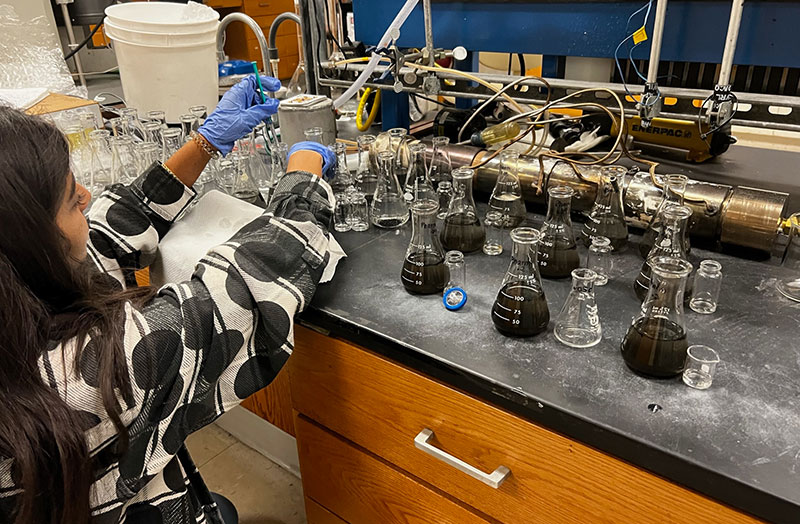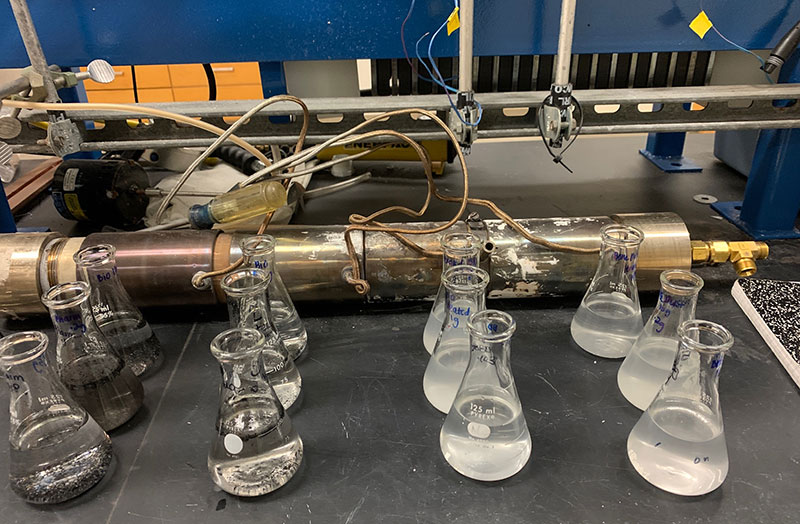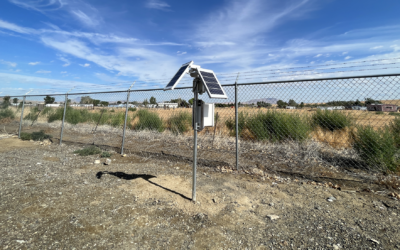DRI Opens Doors to Careers in Scientific Research with Student Internship Program
Jan. 24, 2023
LAS VEGAS, NEV.
By Elyse DeFranco
Fluoride
Water Treatment
Water Filters
The first in DRI’s Behind the Science Blog coverage of our fall 2022 Research Immersion Internship Series.
This fall, DRI brought eleven students from Nevada’s community and state colleges to the Las Vegas and Reno campuses for a paid, immersive research experience. Over the course of the 16-week program, students worked under the mentorship of DRI faculty members to learn about the process of using scientific research to solve real-world problems. This unique internship program welcomes all students, not only those pursuing majors in science, who are in their first or second year of enrollment at local state and community colleges.
Students for the 2022 fall semester joined from the College of Southern Nevada, Nevada State College, and Truckee Meadows Community College.
“Hands-on experience in science, working directly with experienced mentors, is one of the best ways to help students explore careers in scientific fields, and DRI’s internship program opens up this opportunity to more students across Nevada,” says Meghan Collins, M.S., who leads the internship program. “We’re thrilled to have continued support from MGM Resorts and the Hearst Foundations in order to bring more potential future scientists to DRI.”
The students wrapped up their semester-long internships on Dec. 20 by presenting lightning talks about their research to the DRI community. Their research spanned multiple scientific disciplines, from Nevada’s endangered species, to improving access to drinking water quality in Ghanaian communities, to monitoring Earth’s urban climates from space.
DRI’s Behind the Science Blog will highlight each research team’s accomplishments over a series of five stories.
Applications for fall 2023 internships will open in spring 2023.
In this story, we learn about Erick Bandala’s student interns and their quest to find solutions for communities struggling with a persistent and overlooked problem: the health impacts of high concentrations of fluorides in their drinking water.

Left: Intern Shaezeen Vasani tests the efficacy of three different experimental materials in removing fluoride from water. Right: The experimental set-up in Erick Bandala’s lab.
Credit: DRI.

Student Interns Help Erick Bandala Develop a Water Treatment Prototype for Fluoride Removal
Student Researchers: Jennifer Arostegui, Rocio Cortez, Shaezeen Vasani
Faculty mentor: Erick Bandala, Ph.D., Assistant Research Professor of Environmental Science Additional Mentor: Adam Clurman, Student Worker in the Division of Hydrologic Sciences
Fluoride is largely known as a toothpaste additive – the American Dental Association recommends fluoride toothpastes because they help prevent cavities and strengthen tooth enamel. Many communities around the world add fluoride to their drinking water supply for the same reason. But when people consume too much fluoride – more than the 0.7 parts per million recommended by the U.S. Department of Health and Human Services – a number of health problems can arise.
“Normally, we hear positive news about fluoride – that it has been proven to rebuild and strengthen tooth enamel,” said intern Rocio Cortez. “However, a high concentration can pose a great danger.”
The Risks of Fluoride Over-Consumption
Fluorides are actually compound elements where the element fluorine combines with other substances, usually metals. They naturally occur in Earth’s rocks and soils, following rain and erosion to make their way into watersheds. Nearly all water contains some level of fluorides, but the geologic history of a region can sometimes lead to far higher levels than average.
Once inside the body, fluorides move through the bloodstream and concentrate in areas with higher calcium, including teeth and bones. Persistent exposure to higher levels can cause dental fluorosis, which discolors teeth and increases the risk of tooth decay. However, some communities are exposed to such high levels of fluorides that skeletal fluorosis can occur, which results from the buildup of fluorides in bones. This leads to joint stiffness and pain, brittle bones, and bone fractures.
“At high levels, fluoride starts to replace calcium in the teeth and bones,” said faculty mentor Erick Bandala. “And we have found places – for example, in Ghana – where the fluoride concentration may be as high as 50 milligrams per liter, which is far higher than the guideline of 1.5 milligrams per liter set by the World Health Organization (WHO).”
Closer to home, Bandala’s research team found wells in central Nevada’s Walker Lake Indian Reservation where the fluoride concentration is around 5 milligrams per liter, nearly three times the WHO guideline.
Excess fluoride can be removed from water with the aid of specialized filters and reverse osmosis, but many communities don’t have access to the proper technology, or the expertise needed to maintain it. Recognizing this, Bandala set out to identify inexpensive, readily available materials that can be used as water filters.
“We are developing materials that can remove contaminants from the water using the concept of circular economy,” Bandala said. “This means that we want to use material that for someone is considered a waste and turn it into something that can be used for water treatment.”
Researching Water Filters for Fluoride Removal
For their internship project, the students examined the potential efficacy of three different materials for removing fluorides from water. The first material, calcium hydroxyapatite (or “bone dust”), is derived from cattle bones. The second, sulfuric biochar, is created from pine wood that had been infected by beetles. The third material, phragmites, is a common invasive plant found in wetland areas.
“For our experiments, the materials were under a process called chemisorption,” said intern Jennifer Arostegui. “This process uses high pressure and high temperatures.”
Chemisorption causes new chemical bonds to form, allowing fluorides to bind to the experimental material and be subsequently removed from the water. The students tested various concentrations of each material over the course of approximately 70 different tests. Their results showed that unheated calcium hydroxyapatite was the most effective at filtering fluoride from water, followed by sulfuric biochar and then phragmites.
Another experiment examined each material to determine whether it was hydrophobic (water repelling) or hydrophilic (water attracting) and compared this to their results for fluoride removal. The students found that this wasn’t a critical factor in determining how effectively the experimental materials scrubbed fluoride from the water.

The interns tested how efficiently three different materials removed fluoride from drinking water: calcium hydroxyapatite, sulfuric biochar, and phragmites.
Credit: DRI.
Embracing the Research Experience
The student researchers benefitted from their hands-on experience in the lab as well as immersion in the DRI community. They shared some of their highlights and surprises, as well as how the internship helped guide their future studies and careers.
“This experience was eye opening,” said intern Shaezeen Vasani, a student at the College of Southern Nevada studying physical sciences. “Every day I learned something new and could not wait to come back in to continue my project. Every time I thought I learned everything, something new would be brought to my attention.”
Vasani said she was surprised by the scientific process, especially when experimental results varied from her expectations. “While running tests, our numbers should have been decreasing but instead it was increasing for some of the materials,” she said, referring to the fluoride concentrations with treatment. “We later learned from our mentor that this could be due to the chemical properties in some of the materials and their interaction with our project’s contaminants.”
For intern Arostegui, the highlight of the internship experience was the ability “to actually get involved and introduced to a laboratory outside of school. In our group, we learned how to use a spectrophotometer, use reagents/stock solutions, and weighed/prepped our own samples.”
She says she was surprised to be part of a research team that respected her as a collaborator. “The biggest surprise for me was being referred to as a ‘scientist,’ ‘researcher,’ and even ‘engineer’ by my mentor and colleagues,” she said. “I have only seen myself as a student.”
Arostegui is studying environmental management at the College of Southern Nevada and has a specific interest in water resources and says that the internship encouraged her to continue studying hydrology and geology. “This was such a positive experience to be a part of,” she said. “I am forever grateful.”
Prior to the internship, intern Rocio Cortez had focused her undergraduate studies on business administration. Now, she says her career goals have shifted. “I have put in some thought into pursuing a graduate degree that relates to STEM,” she said. “In addition, it has also made me want to volunteer and look for opportunities similar to this internship.”
“When I first started the internship, I really did not know what to expect,” Cortez said. “Through every step of the way, my teammates and I received guidance and support from our mentor… I would like to thank DRI for having this internship and opening its doors to students outside of STEM.”
More Information
To learn more about the DRI Research Immersion Internship, go to https://www.dri.edu/immersion/.


